PlayStation 3: Kikizo Hands-On Feature
As the world's first consumers pick up a PS3, we share our thoughts on the console we've been playing since pre-launch and include a bit of an obligatory photo shoot as well. And this time, we can even mention games...
Page 2
With the machine off, placing a disc very slightly into the Blu ray drive will switch the machine on, before the disc is swallowed inside and booted. It's nice.
 | ||
| Forget spot the difference, feel it; PS3 control is much lighter | ||
This time though, it wasn't our fault, nor the makers of PS3. But, it seems Mr Sony had let people have a fiddle on this PS3 before it landed here (to be expected, given it's an older debug) and the controller actually required a recharge! Not something we expected to be doing so soon, but it did prove how simple a process it is.
The supplied USB lead plugs into the controller and then into one of the PS3's low front-positioned USB slots. The charge initiates immediately and a full charge seemed to finish after a couple of hours, according to the PlayStation logo on the front of the controller, which glows red during a charge and stops glowing when done. There's no way to open the controllers up and change the batteries in the event they become worn out, but Sony recently stated that the technology used doesn't wear out anywhere near as quickly as traditional lithium-ion batteries, and Phil Harrison has even said somewhere that if such a time comes, Sony would replace dead controllers. [Update - the Japanese manual actually shows how to replace the batteries].
[Update]: Incidentally, Sony points out that the full 2.5-hour charge will give about 30 hours of use. They tell us they'd used it for "three weeks" solid without having to charge - no wonder it needed some love when we got it...
The controller is very quick to sync with the system. About twice as fast as Xbox 360 in fact, at around one second. Apparently, on first use, PS3 actually requires the connection of the USB charge cable anyway, in order for the initial sync to take place, but we wouldn't have noticed since we used the cable to charge regardless. Unlike with Xbox 360, this physical link is required to get things on the road.
PlayStation 3's slick, elegant Cross Media Bar (XMB) front-end is a winning solution for Sony, having made its debut on the PSP and now working tremendously well in high-definition on the PS3. Since the last use of this machine was via a SCART video connection, initially the machine powered on in standard definition, but it was easy to change the display settings across standards and didn't require a reboot afterwards like Xbox 360 would. Inside the settings menu, the display options are comprehensive, allowing you to specify what cable you're using, choose from pre-set resolutions or a custom resolution, and so forth. Once our preferred 720p was up and running, the PS3 front-end looked crisp and much more at home in familiar, eye-bleeding quality. This called for a reboot on our terms, just so we could see the start sequence again properly!
PS3's front-end is such an improvement over that of PlayStation 2's confusing, messy equivalent it's beyond all recognition. The boot-up sequence, like the whole of the XMB front end, is clean and simple. The sounds, from the PSP browser pings, to the strings of the boot-up music, or the chime of the PS3 logo when a game is loaded, are crisp and classy, and overall the ease of use goes beyond what you'd find on Xbox 360's colour-coded slides and multiple ways of accessing similar information. It's not as good looking or vibrant as 360, but the no-fuss styling is a welcome change and feels very appropriate on a console that is clearly going to be a complex one in so many ways.
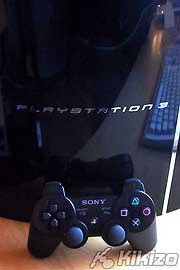 | ||
Profile selection or creation is the first thing that appears after boot-up, before XMB fades into view. As well as comprehensive Settings area, along with Photo, Music, Video, Game and Network icons on the horizontal axis, there's also the Friends icon at the end, where you're prompted to sign up for the PlayStation Network if you haven't already.
Creating a user profile, then, was the first order of business, and it's here that PS3's simple text interface first comes into its own. With a mobile phone keypad layout, you simply spell the word out by pushing buttons as you would on a cellphone, and where relevant, predictive text suggestions are also listed on the right for you to select if appropriate. Somehow, Sony forgot to put our username, Kikizo, in the PS3's internal dictionary.

 PS3 also borrows cell-style text inputting from PSP, but you can plug in a USB keyboard if you like, useful for the lengthy Account sign-up process
PS3 also borrows cell-style text inputting from PSP, but you can plug in a USB keyboard if you like, useful for the lengthy Account sign-up processPersonally I like this PSP-inspired method of entering text on a console, and I think anyone who uses their cell to text regularly will feel comfortable too, though some PS3 users including those on our team who've been messing around with PS3 for some time have said they find the method annoying, and bemoaned the lack of an on-screen virtual keyboard as you would find on Xbox 360. You can, however, connect a USB keyboard to PS3 and enter text the old fashioned (and perhaps most convenient) way. We can probably agree that it would have been nice to have an option of both types of keypad layout.
Once your basic profile is set up in the front end, you can go on to create your PlayStation account via an online connection. For us to do this on the debug, we first needed a quick firmware upgrade to version 1.10, which Sony duly sent over to us on a CD. Copying the contents of a folder to a USB stick and plugging in, then navigating to the system's firmware updater, was all that was needed to get the update underway. A previous glitch in the online registration process was now fixed.
 | ||
Obviously, filling in all the details is a lot less painful if you do plug in a USB keyboard. And since a lot of users will be using the PS3's slick web browsing tool, a wireless keyboard might be a good investment so that you can pull it out and surf properly in living room comfort, a feature which Peter Moore recently told us is not currently planned for Xbox 360.
We've not sampled much more online at this point unfortunately, as this particular debug experience didn't allow for any demo downloads, shop shenanigans or online play. Excitingly we could, however, get PS3 to sync the real-world time accurately using the Internet connection! But elsewhere, we'll have online gameplay impressions of some PS3 titles on the way in separate previews to follow.
While Xbox 360 is online out of the box and integrated into every aspect of console, the PS3 doesn't yet seem to incorporate it across the board to the same degree; creating an online profile takes a while, friend notification, achievements and invites to play are not streamlined as they are on the Microsoft platform, and so forth. Sony argues that this is because the PS3 is more of an open platform that will allow developers to build such features into their own games as they please, but clearly Microsoft would tell you it's vital to a consistent and a cohesive play experience. We're going to continue to study this side of PS3 over the coming weeks and offer an updated view of things - after all, Sony can update the way that PS3 works in the same way Microsoft can with software updates, it's just a question of pulling its finger out on the software side of things.
With the huge hard disk space available, its nice to see Sony have taken a leaf from the original Xbox in allowing HDD saves. Currently, there doesn't seem to be a way to save or load game save items using the various flash memory cards that the PS3 console supports, but from the dashboard, non-copy protected data can be copied to the these cards. Whether that's just a launch feature which will be fixed in future firmware updates, or something permanent is currently unknown, but otherwise we could see a lot of disappointed sport game fans having to go through a long process in order to take their customised team over to a friend's house for a play. Now that PS3 is out of the door, the next priority has got to be tackling things like this - after making a few more consoles, that is.
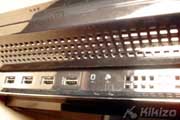

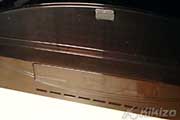
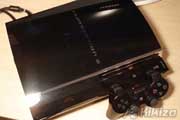 With the hard disk space available, you can easily save games, but flash memory readers in the 60GB model are for other data and media
With the hard disk space available, you can easily save games, but flash memory readers in the 60GB model are for other data and mediaSo next, let's talk briefly about the hardware itself. We've had something of a love affair with the PlayStation 3 design since its initial mock up was held high by Kutaragi at E3 2005. And it's certainly seen a few changes since then. We can't help but smile and admire Sony's vision, looking back at that E305 mock-up and comparing it to the machine we've got here today, and particularly from the back where all the cables go, it's a completely different machine. (See the old version pictures here for comparison).
Nonetheless, we must stress that we like this final design more than we like the original mock-up. In your hands or on your table, it's big and heavy. It's easily bigger than an Xbox 1, and as heavy as all previous consoles combined - possibly. It's a thick, fat, big black powerhouse of hardware whose slick exterior belies the insane power inside that soaks up twice as much energy as an Xbox 360, reportedly enough to add a chunk to your annual electricity bill...




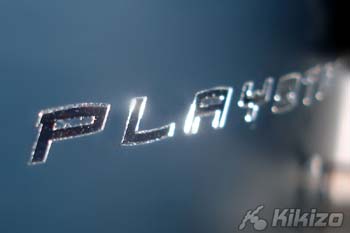
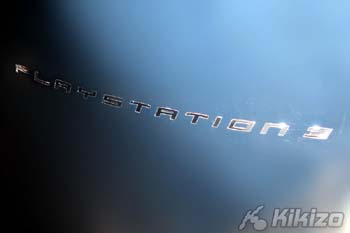

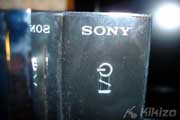
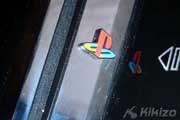
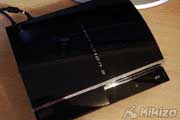
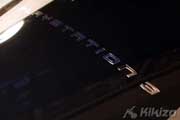





 Satoru Iwata Video Interview - the late Nintendo president spoke with Kikizo in 2004 as 'Nintendo Revolution' loomed.
Satoru Iwata Video Interview - the late Nintendo president spoke with Kikizo in 2004 as 'Nintendo Revolution' loomed. Kaz Hirai Video Interview - the first of Kikizo's interviews with the man who went on to become global head of Sony.
Kaz Hirai Video Interview - the first of Kikizo's interviews with the man who went on to become global head of Sony. Ed Fries Video Interview - one of Xbox's founders discusses an epic journey from Excel to Xbox.
Ed Fries Video Interview - one of Xbox's founders discusses an epic journey from Excel to Xbox. Yu Suzuki, the Kikizo Interview - we spend time with one of gaming's most revered creators.
Yu Suzuki, the Kikizo Interview - we spend time with one of gaming's most revered creators. Tetris - The Making of an Icon: Alexey Pajitnov and Henk Rogers reveal the fascinating story behind Tetris
Tetris - The Making of an Icon: Alexey Pajitnov and Henk Rogers reveal the fascinating story behind Tetris Rare founders, Chris and Tim Stamper - their only interview? Genuinely 'rare' sit down with founders of the legendary studio.
Rare founders, Chris and Tim Stamper - their only interview? Genuinely 'rare' sit down with founders of the legendary studio. The History of First-Person Shooters - a retrospective, from Maze War to Modern Warfare
The History of First-Person Shooters - a retrospective, from Maze War to Modern Warfare